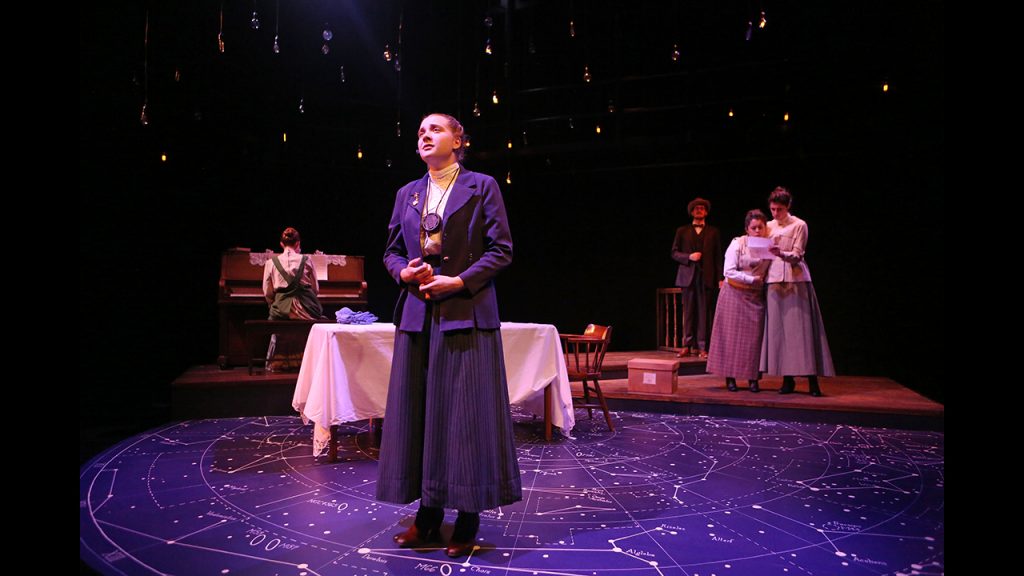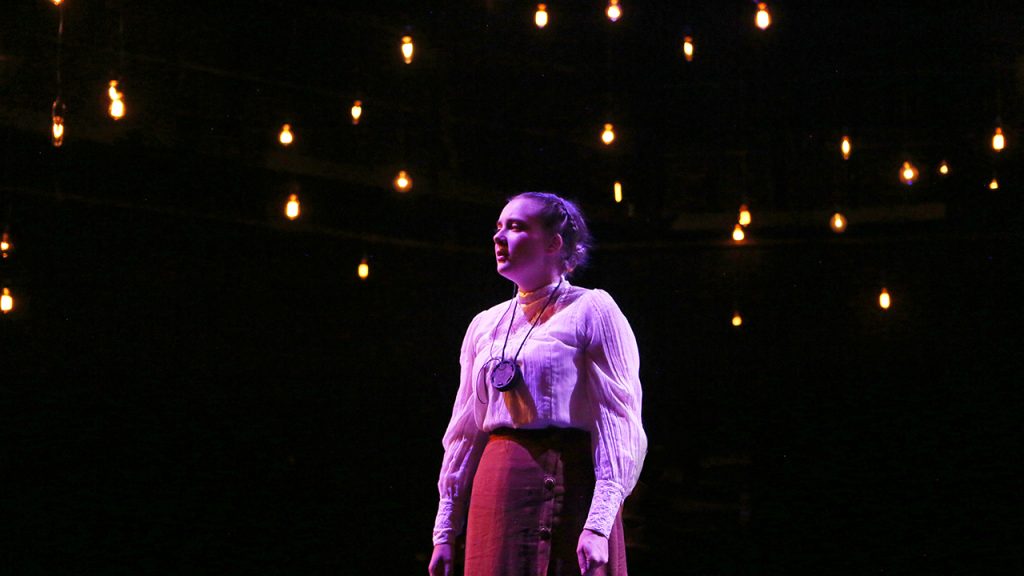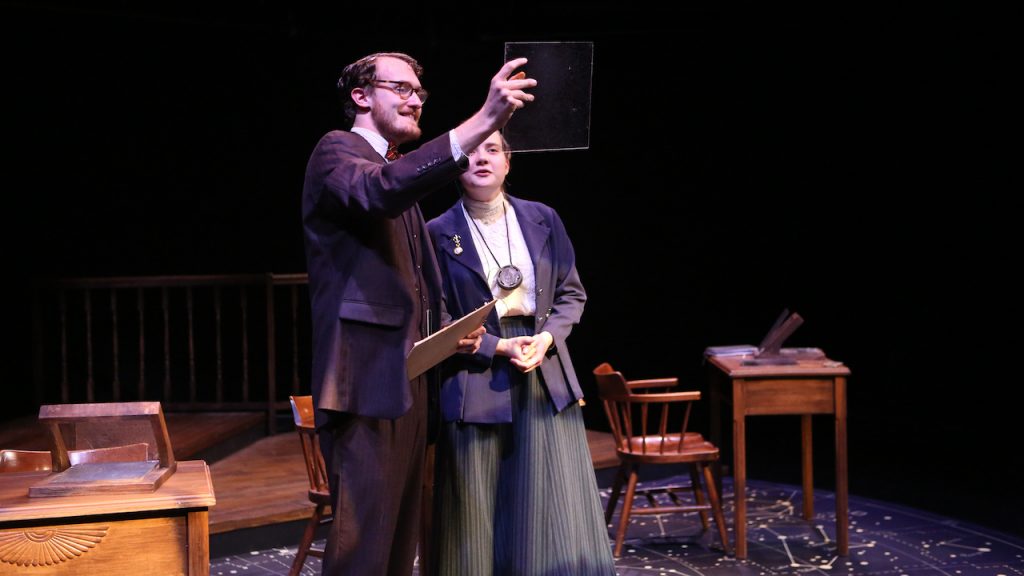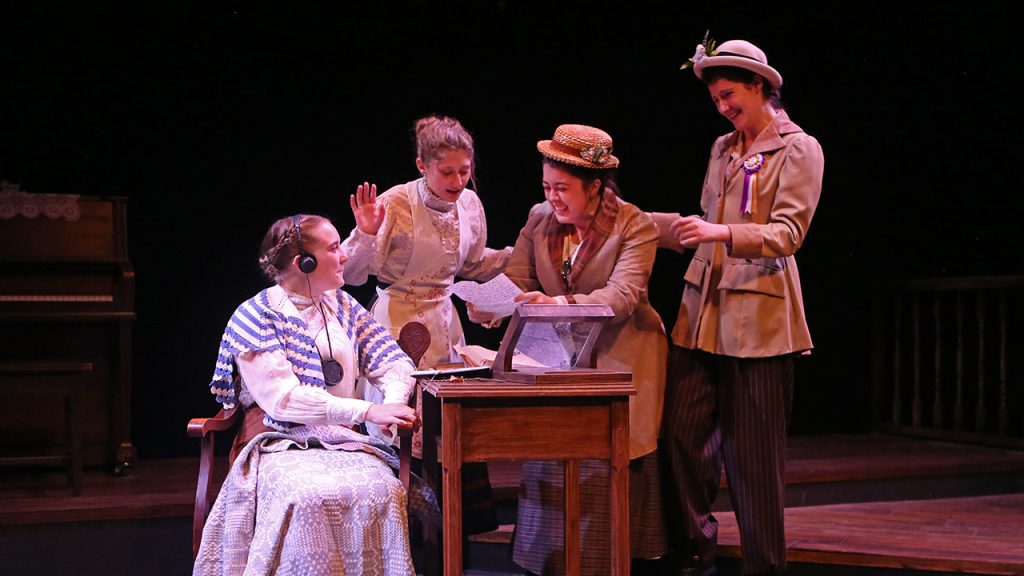Written by Reyn Ricafort ’25

Last Friday, Skidmore College premiered its Black Box production of Silent Sky by Lauren Gunderson, directed by Theater faculty member Dennis Schebetta and designed by a talented array of Skidmore students (along with staff member Patty Pawliczak as Costume Designer). The play follows the life of astronomer Henrietta Leavitt who is credited with discovering the period-luminosity relation, a discovery that would transform the astronomical landscape for years to come.
Set in the early 1900s, the play begins with Henrietta at the front of the stage as she speaks out into the audience with mischievous wonder; she refuses to believe that a “heaven” could replace the billions of stars, or “exceptions” as she calls them, represented by meticulously hung lights glowing above the actor. Her speech is cut short by her sister Margaret, who beckons her to come to church which she is late for. Henrietta, having just debased the notion of heaven a couple of lines before, refuses and chooses instead to reveal to her sister that she has been offered a job at the Harvard Observatory as an astronomer. Margaret is astounded at Henrietta’s radical decision to accept the offer and fears that she will lose sight of her roots and in turn, forget her family. Henrietta assures her sister that this will not be the case and steps brazenly forward toward her new path.

Upon arriving at the observatory, Henrietta meets her superior Peter Shaw, a clumsy and incoherent man who can’t help but make slightly sexist jokes at Henrietta’s presence. Although Peter Shaw is a likable character, due to his endearing nature and benevolence towards Henrietta and her colleagues, he becomes the vessel for which audience members get a glimpse of the misogyny that runs rampant in astronomy, even if subtle and implicit like with Peter.
Henrietta meets her colleagues Annie Cannon and Willamina Fleming, two remarkable women of their own right who help Henrietta navigate the male-dominated world of astronomy throughout the play. Despite her glittering new job, aside from its misogynistic constraints, Henrietta is unable to escape the chord that tethers her back to her roots: Margaret. This becomes a recurring struggle in the play as Henrietta reckons with the different aspects of her identity and circumstances, all pulling her in different directions. The theme of spatiality is explored both within the play and outside of it to a tremendous degree. Thanks to the production’s minimalist circular stage adorned with hanging light bulbs that glow in unison with the story’s action, the characters transcend time and space as they communicate to one another through letters, recited by the actors in the same tiny theater. As Henrietta says both to Margaret and to Peter: afar but not apart.

Despite Henrietta’s promising discoveries at the observatory, she struggles to find a pattern that would give her research some significance in the astronomical community, causing her to fear the possibility of never making an impact with her findings. Luckily, Cannon reassures her that this will not happen so long as she perseveres and continues with her work.
After Henrietta’s father dies, she is forced to leave the Observatory and return to her sister Margaret. It is there that Henrietta discovers her period-luminosity relation after listening to Margaret play the piano and being inspired by its reliance on a pattern. Shortly after the discovery, Henrietta moves back to Boston to continue her work at the Harvard Observatory but is constrained by a developing illness that does not allow her to leave her home. Despite this, her discoveries would go on to be used in the scientific community which culminates in one of the play’s most heartwarming moments, when all four characters celebrate Henrietta’s achievements.

Perhaps one of the most admiring aspects of this play is its commitment to telling the story of Henrietta Leavitt, one of history’s most overlooked figures, despite her grand achievements. The play seems to address this issue of being forgotten through Leavitt’s struggle to find any significance and meaning in her work, an obstacle that could hold one back as the science community continues to progress forward. Luckily, the Black Box allows Henrietta to reach all crevices of the space, offering her wisdom and story to every audience member in the room. But, even if there was no Skidmore production, no Silent Sky, and no Lauren Gunderson, Henrietta’s work could never be forgotten, for much like a star that dies in the lonely vacuum of space, her light and impact will continue to burn.
